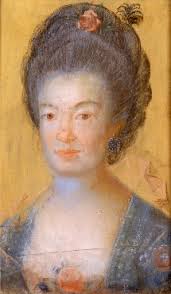Elisabeth Christina von Linné facts for kids
Quick facts for kids
Elisabeth Christina von Linné
|
|
|---|---|

Elisabeth Christina von Linné, painted by Sven Nikolaus Höök
|
|
| Born | 1743 |
| Died | 1782 |
|
Notable work
|
Om Indiska Krassens Blickande (Concerning the flickering of the Indian crass) |
| Spouse(s) | Carl Fredrik Bergencrantz |
| Children | Carl Fredrik Sara Elisabeth |
| Parents |
|
| Family | Linné family |
Elisabeth Christina von Linné (1743–1782) was a Swedish botanist. She was the daughter of the famous scientist Carl Linnaeus and Sara Elisabeth Moræa.
Life and Education
We don't have much information about Elisabeth Christina von Linné's formal schooling. Her brother received lessons at home to prepare for university. Elisabeth also spent time with her father's students, who were tutored at their home. It's likely she also received home lessons from the same teachers. This was a common way for children to learn in Sweden back then.
She knew many of her father's students. These included Erik Gustaf Lidbeck and Daniel Solander. Elisabeth reportedly wanted to marry Daniel Solander. However, he did not return from his travels, so the marriage never happened.
In 1764, Linné married Carl Fredrik Bergencrantz, who was a major in the army. They had two children. A few years after her wedding, she separated from her husband. She moved back to live with her parents. Elisabeth died at 39 years old. Sadly, both of her children also passed away before they became adults.
Scientific Discoveries
Elisabeth Linné is often called the first female botanist in Sweden in a modern sense. This is true even though she did not have a formal education.
She was the first person to describe a special optical event. This is when the Tropaeolum majus flower, also known as the Indian cress, seems to send out small flashes of light. This amazing event is now named the Elizabeth Linnæus Phenomenon after her.
In 1762, when she was 19, she wrote about her observations. She published her paper for the Royal Swedish Academy of Sciences. The paper was titled Om indianska krassens blickande, which means "Concerning the flickering of the Indian crass."
Her paper caught the attention of Erasmus Darwin. He was an English doctor, scientist, and poet. He mentioned her work in his book, "The Botanic Garden, Part II" (1789). In his book, he also confirmed the phenomenon. He mentioned M. Haggren, a natural history lecturer, who had also published findings about it.
Later, famous poets William Wordsworth and Samuel Taylor Coleridge read Darwin's accounts. These stories influenced their own poems. Wordsworth wrote about "flashing" flowers in "I wandered lonely as a cloud." Coleridge also mentioned a "fair electric flame" in his poem "Lines Written At Shurton Bars..." So, through Erasmus Darwin, Elisabeth Linné's discovery helped inspire early English Romantic poetry.
See also
 In Spanish: Elisabeth Christina von Linné para niños
In Spanish: Elisabeth Christina von Linné para niños

